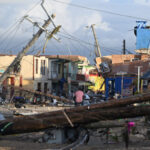Families of at least five passengers killed when a plane crashed into a home last year have reached settlements with the airlines involved, and more agreements are expected before a wrongful-death trial begins, lawyers said.
So far, 39 lawsuits have been filed in U.S. District Court since the Newark, N.J.-to-Buffalo flight plunged into a house in suburban Clarence on an icy February night, killing all 49 people aboard the plane and the home’s owner. Terms of the settled cases haven’t been disclosed.
During a conference Wednesday with the dozens of lawyers involved in the lawsuits, Judge William Skretny said he likely would rule in the next month on the key issue of whether jurors in the trial, scheduled for March 2012, will be allowed to hear the full cockpit voice recording.
Lawyers for the victims’ families say the unedited recording of Continental Connection Flight 3407 will go beyond the already released written transcript in illustrating an overly relaxed atmosphere in the cockpit, which investigators have said contributed to the Feb. 12, 2009, crash.
“Why we think (the recording) is significant is, how were the pilots acting in the cockpit? You can’t really tell that by pure words, you need the sound,” said attorney Hugh Russ, who represents some of the families. “Also, what other sounds might there be? Might we hear the passengers? Might it show that the passengers were aware of what was happening?”
Attorneys for the airlines say the written transcript of the conversations between Capt. Marvin Renslow and First Officer Rebecca Shaw is sufficient.
The lawsuits name Houston-based Continental Airlines; Colgan Air, the Manassas, Va., regional carrier that operated the flight, and Colgan parent Pinnacle Airlines, of Memphis, Tenn. Also named in some cases are Montreal-based Bombardier Aerospace, which made the plane, and FlightSafety International, which helped train the pilots.
The National Transportation Safety Board in February said that the pilots’ improper response to a low-speed warning led the plane to go down just five miles from its destination. Among contributing factors, the panel said, were the crew’s inattention to airspeeds and violation of regulations prohibiting unnecessary conversation during takeoffs and landings.
While the NTSB findings cannot be used in court, they parallel claims in the lawsuits that the pilots were improperly trained and made errors.
In court papers, the defendants have denied allegations that they recklessly operated and monitored Flight 3407, that they improperly trained its crew and that the aircraft was not equipped to fly in icy conditions.
Was this article valuable?
Here are more articles you may enjoy.

 ‘Super Roofs’ Are Rewarding Insurers, Cat Bond Investors and Homeowners
‘Super Roofs’ Are Rewarding Insurers, Cat Bond Investors and Homeowners  Abbott Presses Congress for Shield Over Preemie Baby Formula Litigation That Could Cost It Billions
Abbott Presses Congress for Shield Over Preemie Baby Formula Litigation That Could Cost It Billions  Florida And East Coast Will See Big Losses From More Cat 5 Storms, Researchers Say
Florida And East Coast Will See Big Losses From More Cat 5 Storms, Researchers Say  Standard Chartered Settles $2 Billion Iranian Sanction Suit in London
Standard Chartered Settles $2 Billion Iranian Sanction Suit in London 